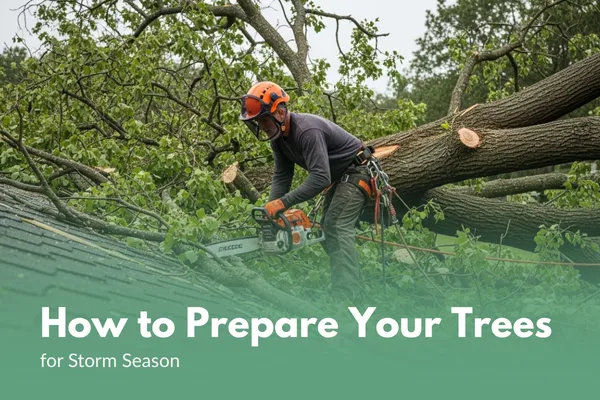
How to Prepare Your Trees for Storm Season
Around here, when storm season rolls in, we all keep a close eye on the weather.
But while you’re watching the radar or making sure your generator has gas, your trees might be silently preparing for trouble too — or worse, already at risk.
We’ve seen what strong winds and saturated ground can do. We’ve responded to calls in the middle of the night where trees split roofs in half, blocked driveways, or fell across power lines. And we’ll tell you this: 9 times out of 10, there were warning signs beforehand.
So if you want to protect your family, your home, and your wallet before the storms hit, now’s the time to take a good look at your trees. This post will walk you through what to watch for, what you can do yourself, and when to call someone like us to step in.

Know the Signs of a Problem Tree
Not all hazards are obvious. A tree doesn’t have to be leaning or dead to be dangerous. Some of the worst failures come from trees that look fine until they don’t.
Here’s what we look for during a storm prep inspection:
Cracks in the trunk or large limbs
Fungal growth around the base or bark
Dead or hanging limbs (especially up high)
Branches growing over the house or near power lines
Trees with multiple trunks splitting from the same base
Signs of soil heaving or loose roots around the base
Trim It Right or Pay the Price
One of the best things you can do for your trees (and your property) is to get them professionally trimmed before a storm ever hits. That doesn’t mean cutting everything back to stubs — it means smart pruning that reduces weight, balances the canopy, and removes weak limbs.
We always say: a $300 trim in August is cheaper than a $3,000 roof repair in September.
Watch for Root Problems
Storm damage doesn’t just come from above. Saturated ground can soften to the point where even strong, healthy trees can topple if their roots aren’t well anchored — especially larger species like silver maples or older oaks.
What you can check:
Is the soil around your tree loose, cracked, or lifting?
Do you see exposed roots or water pooling at the base?
Is the tree leaning more than it used to?
Don’t Forget the Smaller Trees
A young tree may not seem like a big threat, but if it’s not staked properly or if it’s growing unevenly, it could break or fall — and damage siding, fences, cars, or other plants.
Use soft ties, give it room to grow, and keep it pruned. And if you planted something close to the house a few years ago that’s now brushing your gutters? Might be time to reassess.
Emergency Plans Matter Too
We tell all our customers to keep a few things in place for storm season:
Our phone number: +1 (304) 600-7805 — available for 24/7 emergency tree calls
Know where your power shutoff and breaker box are located
Keep cameras or phone handy to document damage for insurance
Don’t try to handle downed trees yourself — especially near wires
Regular Checkups Save You Thousands
Our certified arborist (Hunter) performs pre-storm tree risk assessments all summer long. We’ve spotted dozens of failing limbs or hollow trees before they came down — saving homeowners from thousands in damage or injury.
It’s a simple process. We walk your property with you, inspect every tree, and give clear next steps. Sometimes it’s trimming. Sometimes removal. Sometimes it’s just peace of mind.

Closing Thoughts from Rick and Hunter
We love trees. They’re part of what makes your yard feel alive. But they can also be a danger if they’re ignored — especially in storm season.
If you’re not sure whether your trees are healthy, safe, or strong enough to withstand the weather, don’t wait until the wind is blowing. Give us a call. We’ll take a look and help you get ahead of it.

